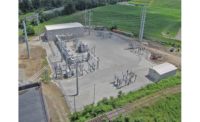Interstate Reliability Project
Wallingford, Conn.
Best Project
Owner Eversource Energy
Lead Design Firm Burns & McDonnell
General Contractor Burns & McDonnell
Civil Engineer Burns & McDonnell
Overhead Transmission Line Contractor PAR Electric
Right of Way Clearing Northern Clearing
Environmental Survey and Permit Support AECOM
Siting/Permiting Support Phenix Environmental
Geotechnical Studies Haley & Aldridge
Right-of-Way Clearing and Access Road Contractor Northern Clearing
The $218-million Interstate Reliability Project installed a series of interconnections to improve power reliability on the New England grid.
The joint effort between Eversource Energy and National Grid spanned three states: Rhode Island, Massachusetts and Connecticut. The Connecticut portion includes 37 miles of 345-KV overhead transmission line and three substation/switching station upgrades. More than 300 transmission structures were built along with more than 30 miles of new or rehabilitated access roads in the Connecticut portion.
The project’s scale and scope made community concerns a major focus. The project route extended through largely rural areas with right-of-ways on significant stretches of agricultural land, undeveloped woodlands and several types of waterways. Landowners were sensitive to potential impacts on property values due to vegetation clearing, altered viewscapes and environmental effects. Customized construction plans minimized negative impacts to farmland, and the team’s liaison worked closely with community stakeholders.
The team managed difficult terrain and subsurface conditions with the design and installation of several guy wire transmission line structures. Due to variable and difficult subsurface conditions, the typical guy anchors were often laborious to install or could not meet design capacity. The design team custom-designed several location-specific slug anchors to support guyed structures to reduce installation time and maintain the project schedule.
The broad mix of site conditions across the project route created additional safety concerns. The project’s safety plan began in the early phases with an emphasis on task-specific safety observations and trend analysis. Team members were responsible for conducting safety observations and documenting findings. Project safety management would then review the data by activity, crew, location, company and other factors to determine leading safety incident indicators. The team then addressed concerns and issued corrective actions. Custom-built mobile technology was used for these observations, which allowed safety managers to review trends in nearly real time and enabled management to spend more time on site with the crews.
Crews completed 930,839 worker hours with an OSHA recordable incident rate of 0.43 and no lost-time accidents.
As a linear project, maticulous sequencing and scheduling were required to ensure that construction could progress continuously with no delays caused by late deliveries of equipment or materials or unavailable crews. Program managers gave consideration to electrical system outage constraints, seasonal or site-specific environmental restrictions and extreme weather.
Careful planning and proactive field reviews helped the team avoid surprises during ongoing construction activities. Integrated team field reviews were performed for safety, environmental/permitting, community outreach, construction contractors and other key stakeholders. The field reviews improved work practices and pre-mobilization requirements. The efforts paid off, as the project was successfully completed ahead of schedule and under budget.






Post a comment to this article
Report Abusive Comment